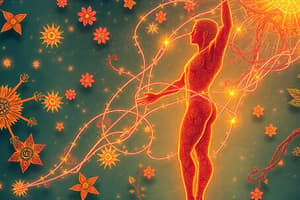Podcast
Questions and Answers
What is the role of ATP in muscle contraction?
What is the role of ATP in muscle contraction?
Which of the following molecules is NOT a high-energy compound that can be used to regenerate ATP?
Which of the following molecules is NOT a high-energy compound that can be used to regenerate ATP?
Which of the following statements correctly describes the difference between substrate-level phosphorylation and oxidative phosphorylation?
Which of the following statements correctly describes the difference between substrate-level phosphorylation and oxidative phosphorylation?
Which of the following is NOT a characteristic of oxidative phosphorylation?
Which of the following is NOT a characteristic of oxidative phosphorylation?
Signup and view all the answers
What is the role of NAD+ and FAD in catabolism?
What is the role of NAD+ and FAD in catabolism?
Signup and view all the answers
What is the primary role of ATP in cells?
What is the primary role of ATP in cells?
Signup and view all the answers
What are the two major components of metabolism?
What are the two major components of metabolism?
Signup and view all the answers
Which of the following processes is an example of an anabolic reaction?
Which of the following processes is an example of an anabolic reaction?
Signup and view all the answers
What is the structure of ATP?
What is the structure of ATP?
Signup and view all the answers
Why is ATP considered unstable?
Why is ATP considered unstable?
Signup and view all the answers
What is the main function of the ATP-ADP cycle?
What is the main function of the ATP-ADP cycle?
Signup and view all the answers
How does ATP provide energy for cellular processes?
How does ATP provide energy for cellular processes?
Signup and view all the answers
Which of the following is NOT a type of energy transduction that organisms carry out?
Which of the following is NOT a type of energy transduction that organisms carry out?
Signup and view all the answers
Flashcards
ATP
ATP
A primary energy carrier in cells, converted from ADP + Pi during muscle contraction.
Substrate-level phosphorylation
Substrate-level phosphorylation
ATP production using energy from breaking high-energy bonds, often without oxygen.
Oxidative phosphorylation
Oxidative phosphorylation
ATP production involving the electron transport chain and oxygen, catalyzed by ATP Synthase in mitochondria.
Catabolism
Catabolism
Signup and view all the flashcards
Oxidation
Oxidation
Signup and view all the flashcards
ATP-ADP Cycle
ATP-ADP Cycle
Signup and view all the flashcards
Metabolic Pathways
Metabolic Pathways
Signup and view all the flashcards
Endergonic Reactions
Endergonic Reactions
Signup and view all the flashcards
Exergonic Reactions
Exergonic Reactions
Signup and view all the flashcards




